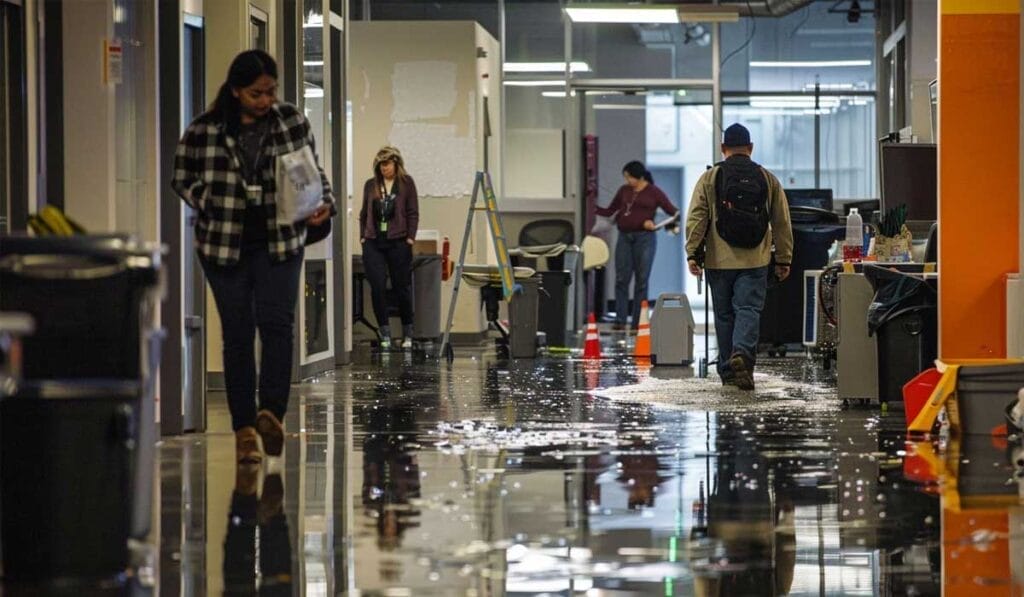How To Handle A Work-Related Slip And Fall Injury
Accidents at work can happen to anyone.
Maybe you’ve slipped on a wet floor or tripped over some uneven flooring.
This is painful and could lead to serious injuries, like a head injury or even something more severe, such as traumatic brain injuries.
It’s scary and can leave you worried about medical bills, lost wages, and how to get the help you need.
According to the Centers for Disease Control and Prevention (CDC), slips, trips, and falls are among the top causes of workplace injuries in the United States.
Understanding your rights under workers’ compensation can be a lifeline during this tough time.
In this article, we will guide you through handling a slip-and-fall accident at work – from getting medical attention right away to dealing with insurance companies if your claim gets disputed.
Key Takeaways
Immediate Actions Required
First Steps
- Seek immediate medical attention.
- Report incident to employer promptly.
- Document scene with photos.
- Collect witness information.
- Keep detailed notes of events.
Documentation Needs
Essential Records
- Medical reports and diagnoses
- Incident report details
- Photos of accident scene
- Witness statements
- All related expenses
- Communication records
Legal Considerations
Rights Protection
- Workers’ compensation benefits
- Medical treatment coverage
- Lost wage compensation
- Legal representation options
- Claim filing deadlines
- Appeal processes if denied
Medical Response
Health Priorities
- Immediate injury assessment
- Follow-up care planning
- Treatment documentation
- Specialist referrals if needed
- Recovery monitoring
- Key Takeaways
Prevention Strategies
Safety Measures
- Regular workplace safety audits
- Proper safety protocols
- Hazard identification
- Employee safety training
- Maintenance schedules
- Emergency response plans
Immediate Actions After a Slip and Fall at Work

If you slip and fall at work, acting fast is key. First, get medical help to check for any hidden hurt like head injuries or back pain. Then, tell your boss about the fall as soon as you can.
Make sure to keep notes and pictures of where you fell. This helps a lot if you need to prove what happened later on.
Seek Medical Attention

Go see a doctor right after you fall at work. Even if you feel fine, some injuries like brain traumas or internal bleeding are not immediately obvious. A healthcare professional can find these hidden injuries.
This step is not just about your health; it’s also crucial for any workers’ compensation claim you might make. Medical records serve as proof of your injuries and the care you needed.
Emergency rooms and doctors know how to treat job-related injuries, such as back pain, concussions, or even more severe conditions like spinal cord damage or fractures. Tell them exactly how you got hurt at work so they can provide the right treatment and document everything correctly.
Immediate medical attention ensures both your well-being and strengthens your workers’ compensation claim.
Report the Incident to Your Employer
As soon as you get hurt in a work-related slip and fall, tell your boss or another person in charge. This step is crucial for setting off the workers’ compensation process. Detailing the incident fast helps ensure that every detail is fresh and accurate.
Describe what happened, where it took place, and who saw it happen. If possible, mention if poor lighting or a wet floor caused your fall. These details can be very important later on.
Quick action like this can really smooth out your path towards covering medical expenses and getting proper medical care without delays or disputes with employers about what occurred.
Document the Scene
Take photos of where you fell and what caused it. If a wet floor without a sign tripped you, or if there was clutter, get pictures from different angles. These images are solid proof for your claim.
Also, snap pictures of your injuries—bruises, broken bones, or cuts.
Write down everything while it’s fresh in your mind. Note the date and time of the fall. Include details like what you were doing right before the incident and how it happened. If anyone saw you fall, ask for their contact information.
Witnesses can help prove what happened was not your fault but due to negligence at work. This info is crucial for filing a successful personal injury claim against those responsible for occupational safety and health violations leading to traumatic events like yours.
Legal Steps to Follow

After a slip and fall at work, knowing your legal rights is key. Talk to a lawyer who knows about workers’ comp to guide you through the process.
Understand Your Rights under Workers’ Compensation
Workers’ compensation is a safety net for you if you get hurt at work. It’s like a promise from your employer to help cover medical treatment and lost wages if an injury, such as a traumatic brain injury or spinal cord injuries, happens on the job.
You don’t have to prove someone was at fault to receive these benefits. The key point here is that workers’ compensation exists to protect employees, including covering costs for things like emergency department visits, physical therapy, and pain and suffering.
Consulting with a workers’ compensation lawyer can shed light on the specifics of your case. They can guide you through the process, ensuring all necessary paperwork is filed correctly and on time.
A lawyer understands personal injury law deeply – they know about traumatic brain injuries (TBI), herniated discs, severe head injuries, sprains and strains – and how these impact your life and work.
With their expertise in occupational safety and health administration guidelines, they ensure you get the vocational rehabilitation or damages deserved without falling into common pitfalls that might weaken your claim.
Consult a Workers’ Compensation Lawyer
After learning about your rights under workers’ compensation, it’s crucial to take the next step. Talk to a lawyer who specializes in this field. A good personal injury attorney can guide you through the process, making sure you understand all your options.
They have experience with cases like yours and know how to handle disputes with employers or their insurance companies.
A lawyer will help you gather evidence, including witness statements and medical reports detailing your injuries—whether it’s trauma to the head or a spinal cord injury.
They will explain complex legal terms in simple language and offer a free consultation to discuss your case specifics without any upfront cost.
An experienced workers’ compensation lawyer can turn a confusing process into one that’s straightforward and manageable for you.
By consulting with a law firm focused on personal injury claims, they’ll ensure your rights are protected every step of the way. This support is vital, especially if facing resistance from an employer or their insurance company over your claim.
What to Do if Your Employer Disputes the Claim

If your employer says no to your injury claim, don’t worry. You need to collect all the proof you can and find a good lawyer who knows about work injuries.
Gather Comprehensive Evidence
After your work-related slip and fall, collecting strong proof is key.
Take photos of where you fell and anything that caused it, like wet floors or uneven surfaces. Write down everything while your memory is fresh.
Include details about the environment, what you were doing before the fall, and any safety measures that were missing. If you suffered injuries like a skull fracture or swelling, get medical records to show how serious they are.
These documents could be crucial if your employer disputes the claim.
Also talk to witnesses who saw what happened; their statements can support your version of events.
This thorough approach will prepare you for the next step: seeking legal representation.
Seek Legal Representation
Seeking an experienced worker’s comp personal injury lawyer can feel overwhelming, especially after experiencing a work-related slip and fall.
Your well-being comes first; bruising, lacerations, or even more severe injuries like a traumatic brain injury (TBI) demand immediate attention.
Then, finding someone who knows the ins and outs of workers’ compensation becomes crucial. Personal experience taught me that it’s not just about getting representation—it’s about finding an advocate who understands your pain, nerves, and fears.
A personal injury lawyer skilled in workers’ compensation cases will help you navigate the often complicated process of claiming your rightful benefits. They deal with insurance companies daily and know how to present your case effectively to ensure you get what you deserve for your suffering and lost wages.
Not all lawyers are created equal; look for one with proven success in similar cases to yours—a contractor’s compound fracture might need a different approach than a mild traumatic brain injury.
The right legal representation turns fear into hope by fighting for the justice you deserve.
Preventing Future Workplace Slip and Fall Incidents

To stop future workplace accidents, it’s key to check your workspace regularly. Making sure safety steps are in place and everyone follows them can keep you safe at work.
Regular Safety Audits
Conduct safety checks often to lower the chances of workplace accidents. These audits look for risks that could cause slips, falls, and other injuries. They ensure everything meets the required safety standards.
Experts inspect floors, stairs, and spaces where people work to find any dangers. They also check if all workers use safety gear properly.
These inspections help in identifying issues like wet floors or loose wires that can lead to serious injuries like puncture wounds or brain contusions. Fixing these problems fast keeps you and your coworkers safe at work.
Safety protocols then get updated to prevent similar incidents in the future. This practice saves lives and helps avoid legal battles over workplace injuries.
Implementing and Maintaining Safety Protocols
Making your workplace safe starts with robust safety precautions. Carry out regular safety audits to find and fix hazards. These checks help spot anything that could lead to slips, falls, or other injuries.
It’s about checking the whole place—floors, equipment, and emergency exits—and making sure they’re all up to standard.
After finding any risks, act fast to deal with them. Put up signs in slippery areas and make sure spills are cleaned up right away. Teach your team how to be safe at work. This means showing everyone the right way to lift heavy things and the importance of keeping walkways clear.
Keep a close eye on everything by setting up a system for reporting dangers or incidents quickly. Following these steps can help prevent painful accidents like degloving, avulsion, or severe stress fractures—all of which can keep you off work for a long time.
Next comes understanding your rights if an accident happens despite these measures.
Conclusion

After a slip and fall at work, the first steps are clear. You need to see a doctor, tell your boss what happened, and take pictures of where you fell. Knowing your rights is next, which might mean talking to an attorney who knows about workplace accidents.
Sometimes, bosses might not agree with your claim—this is when having strong evidence helps. You also might need that lawyer’s help again.
Making your workplace safer should be a goal for everyone there. This means checking the area often and keeping safety rules in mind every day. These actions aren’t just simple; they can really prevent injuries at work.
Understanding these points shows how you can handle slips and falls better. It also tells us why preventing these accidents matters so much. By following this advice, workplaces become safer for everybody.
If things get tough after an injury at work, finding more information or getting professional advice can make a big difference.
Feel inspired? Every step taken today towards knowing more about workplace safety makes tomorrow a safer place for everyone working there.
FAQs
1. What should you do first if you slip and fall at work?
Right after a fall, it’s key to get medical help, especially if you feel weak or dizzy. These could be signs of something serious like an epidural hematoma or even a depressed skull fracture. Don’t just brush it off — your health comes first.
2. Can resting help recover from a work-related slip and fall injury?
Yes, following the RICE method — rest, ice, compression, and elevation — can really aid in your recovery process. It’s simple but effective for minor injuries like sprains or strains that don’t involve more severe issues such as open fractures or damage to brain tissue.
3. How does workers’ compensation come into play with slip and fall injuries at work?
If you’re hurt because of a slip and fall on the job, workers’ compensation is there to support you financially during your recovery time. It covers medical expenses related to the injury and provides wage replacement benefits if you need time off work to heal properly.
4. When should I worry about symptoms after a slip and fall accident at work?
Pay close attention to any new or worsening symptoms following your accident; things like increased weakness, confusion, severe headaches might point towards serious conditions affecting your nervous system or brain tissue. If these arise,, seek medical attention immediately – better safe than sorry!

